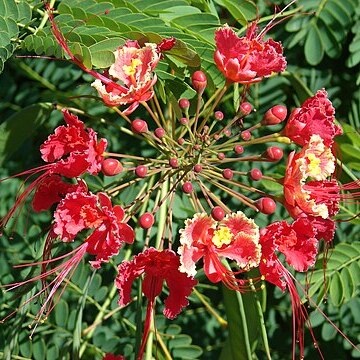Shrubs, erect or more often scrambling or climbing, or trees, armed with spines or prickles or sometimes unarmed. Leaves bipinnate, very rarely (and not in East Africa) reduced to scales (“switch-plant” habit); stipules various, minute to conspicuously leafy; specialized glands restricted to petiole and rhachis absent, although a general glandular indumentum may be sometimes present; leaflets opposite, rarely alternate, glandular or sometimes eglandular. Inflorescences of terminal, sometimes falsely lateral, or terminal and axillary racemes or panicles; rarely racemes much reduced, the flowers thus single or very few together; bracts usually quickly falling. Flowers hermaphrodite, or ♂ ⚥ in C. bonduc and C. volkensii among native species. Sepals 5, imbricate, sometimes very narrowly so, or almost valvate; the lower sepal often cucullate at apex and clasping the others. Petals 5, subequal except for the usually somewhat modified upper one, which usually has a rather smaller lamina and more pronounced claw. Stamens 10, fertile, rarely and casually with 1 ± abortive; filaments alternately longer and shorter, all pubescent or villous and often glandular below; anthers dorsifixed, dehiscing by longitudinal slits. Ovary free, subsessile or shortly stipitate, usually with 2 to ± 10 ovules, glabrous, pubescent or glandular; style glabrous, or clothed below like the ovary; stigma truncate or oblique, ciliolate or glabrous. Pods very variable, usually flat or ± compressed, very rarely cylindrical, not winged, indehiscent or dehiscent and 2-valved, hard and woody or thick and pulpy. Seeds transverse or nearly so, hard; funicle short; endosperm present or absent.
Trees, shrubs or climbers, usually armed with prickles. Leaves bipinnate or reduced to scales; stipules minute to leafy; leaflets opposite, sometimes alternate, sometimes glandular. Flowers bisexual, occasionally unisexual, in terminal or axillary inflorescences, raceme-or panicle-like, occasionally solitary; bracts caducous. Sepals 5, imbricate or valvate, with the lowest commonly clasping the others. Petals 5, subequal or the uppermost with a smaller lamina but larger claw. Stamens 10, free; filaments usually alternately longer and shorter, hairy, commonly glandular; anthers dorsifixed. Ovary sessile or shortly stipitate; ovules 1–10; stigma terminal, oblique. Pod variable, usually flat or somewhat compressed, indehiscent or dehiscent, hard and woody or thick and pulpy or sometimes thin and winged. Seed transverse, not arillate. [Descriptions also provided by Du Puy & Telford (1993: 196–197) and Green (1994: 168–169). The above description from the Flora of Australia Volume 12 (George 1998) requires revision since it included taxa now referred to Mezoneuron, Biancaea and Erythrostemon-Editor, 30 November 2021.]
Trees, shrubs or sometimes vine-like or subherbaceous, armed or unarmed. Leaves twice-pinnate; petioles and rachis eglandular, glabrous or variously pubes-cent; pinnae usually several and opposite or subopposite on the rachis; ultimate leaflets few to many, opposite in pairs, or less frequently alternate, in the pinna. Inflorescence mostly racemose, variously pubescent; bracts normally caducous. Flowers yellowish or less commonly pinkish; calyx with a conspicuous tube and 5 imbricate lobes, the outermost lobe more or less cucullate and enclosing the bud; petals free, nearly equal, inserted upon the upper calyx-tube; stamens normally 10, free, inserted with the petals on the calyx-tube, usually subdeclinate; filaments mostly pubescent, often glandular; anthers small, bilocular, longitudinally de-hiscent, versatile; ovary free, sessile or short-stipitate, inserted at base of calyx-tube; stigma terminal, usually not dilated. Legume compressed or flattened, usually unarmed and dehiscent; seeds transverse.
Trees, shrubs, or climbers, usually with prickles. Leaves alternate, bipinnate; leaflets alternate or opposite, small or large. Inflorescences racemes or panicles, axillary or terminal. Flowers yellow or orange-yellow, medium-large or large. Receptacle concave. Sepals separate, imbricate, lowest one larger. Petals 5, often clawed, spreading, 4 usually orbicular, sometimes oblong, uppermost smaller, different in color, shape, and pubescence from others. Stamens 10, in 2 whorls; filaments thickened and hairy at bases; anthers ovoid or elliptic, dorsifixed and versatile. Ovary 1-7-ovuled; style terete; stigma truncate or hollow at center. Legume compressed or swollen, ovoid, oblong, or lanceolate, sometimes falcate, winged or not, smooth or spiny, leathery or woody, rarely fleshy, dehiscent or indehiscent. Seeds ovoid or globose; albumen absent.
Trees, shrubs or lianes, spinous or not armed. Lvs 2-imparipinnate or 2-paripinnate; petiolar glands 0; stipules various. Infl. axillary or terminal, racemose or paniculate; bracts and bracteoles usually deciduous. Calyx with a very short tube and 5, often unequal, segments imbricate in bud. Corolla yellow, orange, or red; petals subequal. Stamens free, 10; anthers uniform, versatile, opening marginally. Style filiform; stigma terminal. Pod flattened, ovate to lanceolate or falcate, 2-valved or indehiscent.
Leaves bipinnate with paired pinnae; leaflets opposite, glandular or eglandular; without specialised glands on petiole and rachis, though sometimes with a general glandular indumentum; stipules minute to conspicuous and leafy.
Stamens 10, alternately longer and shorter; filaments pubescent to villous and often glandular in the lower part; anthers dorsifixed, dehiscing by longitudinal slits.
Pods very variable, usually compressed, not winged, dehiscent or not, sometimes spiny; seeds variable, endosperm present or absent.
Shrubs, erect or usually scrambling or climbing, or sometimes trees, usually armed with spines or prickles but sometimes unarmed.
Flowers in terminal or lateral racemes or panicles, these rarely much reduced to single or few flowers; bracts usually caducous.
Ovary ± sessile or shortly stipitate, glabrous or with various indumentum; stigma truncate or oblique, ciliolate or glabrous.
Sepals 5, imbricate to sometimes almost valvate, the lowermost curving up to overlap the other 4.
Petals 5, subequal except for the uppermost one which is usually modified in shape and size.
Hypanthium shallow, ± obconic.


